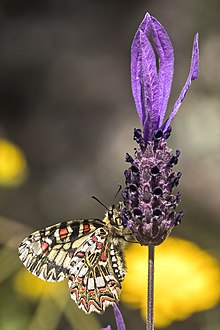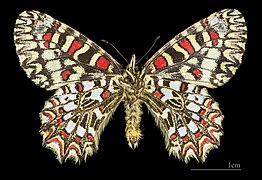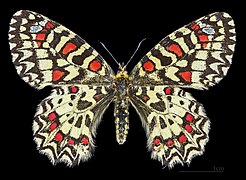349:
325:
337:
313:
42:
387:
33:
406:
55:
375:
916:
306:, from Castilia. — Larva yellow, red, or blackish, with short pale stripes and yellowish red tubercles bearing black hairs; earh' summer, on Aristolochia. Pupa grey -brown, variegated with black. — The butterflies are on the wing in spring, in the South already in February, in North Spain late in March; they are found on sunny slopes and in vineyards, settling especially often on Asphodelus.
874:
902:
363:
268:
Boisd. (10a). is the name of a form in which the red colour is very much extended, the spots of the hindwing merging together to an often broad purple-band. This form occurs in South France, especially in the neighbourhood of Digne, but only very sparingly, the ordinary form of South France being
273:
Ill. (10 a), in which the black spots of the forewing are mostly centred with red, while the red spots of the hindwing remain separate. — Also of these forms melanotic aberrations have been found, that of the
Spanish
728:
is generally considered a
European form but the type locality was fixed 'Algeria' by Cajetan and Rudolf Felder (l.c.) whereas Staudinger (1861) only, and apparently erroneously, referred the name to the Iberian form
247:
by the totally different underside of the hindwing, which bears whitish yellow spots at the base. Nearly all the costal spots of the forewing are marked with red. The 3 or 4 black parallel cell-bars of
256:
enlarged, being separated by thin yellow bands. In Spain and
Portugal, also in Morocco and Algiers, but occurring here only in the coast districts in a slightly different form (10 a). — In ab.
897:
L., an interesting case of sex-linked inheritance: a study of its occurrence in captive-bred specimens and notes about other forms and aberrations (Lepidoptera: Papilionidae). ISSN 0171-0079 |
264:
in South Spain and
Morocco, the ground-colour is dark yellow, almost orange, the transparent apical spot being therefore very prominent, appearing bright silvery. — ab.
243:
233:). The two can be told apart by the presence of blue on the hindwing of the southern festoon. The Spanish festoon also has extensive red on the forewings.
1121:
1170:
348:
737:
Staudinger as an orange aberration of both sexes which is frequent in
Morocco but occasionally appears in warmer parts of south Spain.
324:
1237:
1095:
1270:
985:
336:
1275:
386:
312:
1134:
1056:
920:
1074:
1175:
1087:
170:
402:
The flight period is generally in April and May with the possibility of a very small second brood in
September.
1285:
1280:
1157:
1139:
1004:
538:
1009:
54:
685:
227:
is an extremely striking species. In south east France it can be confused with the southern festoon (
298:
Neub. the third (reduced) black costal spot has no red centre. — Transitions from typical rumina to
717:
514:
1126:
947:
41:
1149:
490:
429:
374:
149:
116:
1201:
1030:
8:
869:
Die Großschmetterlinge des palaearktischen
Faunengebietes, Die palaearktischen Tagfalter
601:
1265:
229:
49:
716:
Heyd. 1851, was originally applied to
African populations and is the valid name, c.f.
1196:
1017:
209:
32:
593:
1022:
933:
362:
1228:
1183:
526:
405:
1162:
1082:
1069:
864:
463:
409:
1259:
970:
878:
721:
166:
1061:
205:
190:
1188:
1108:
996:
979:
567:
106:
1242:
1100:
503:
447:
413:
1113:
1043:
928:
452:
126:
86:
66:
941:
1222:
1048:
964:
581:
877:
This article incorporates text from this source, which is in the
585:
294:
Neub. all the red spots of the forewing are reduced, whUe in ab.
708:
is not the correct one for the northern
African representative.
1035:
915:
597:
589:
213:
194:
96:
76:
733:. Manley and Allcard (1970) following Bryk (1934) referred to
871:, 1909, 379 Seiten, mit 89 kolorierten Tafeln (3470 Figuren)
704:(Northern Africa: Algeria, Morocco: Tangier). The name
260:Stgr. (10 a), which occurs singly among ordinary
1257:
241:T. rumina L. (10 a). At once distinguished from
428:This species represents an extreme example of
282:Oberth., while the black form of the French
40:
31:
189:, is a butterfly belonging to the family
404:
236:
1258:
901:39 (1/4): 337-342, 421. Full article:
712:(Heydenrich i.l.) Staudinger, 1861 (=
946:
945:
1088:b40d1e66-32e9-4612-ac9a-5de37aa1af4b
13:
14:
1297:
908:
867:in Seitz, A. ed. Band 1: Abt. 1,
937:on Guy Padfield's Butterfly Page
914:
872:
397:
385:
373:
361:
347:
335:
323:
311:
193:. It is a widespread species in
53:
200:
858:
219:
1:
1271:Butterflies described in 1758
851:
197:and frequents most habitats.
986:Zerynthia (Zerynthia) rumina
7:
1276:Taxa named by Carl Linnaeus
889:Gil-T., F., 2008: The form
724:(1864), Rothschild (1917),
423:
10:
1302:
392:Habitat, Algarve, Portugal
1212:
954:
155:
148:
50:Scientific classification
48:
39:
30:
23:
832:posteriorrubromarginalis
420:
1286:Butterflies of Africa
1281:Butterflies of Europe
408:
1083:Fauna Europaea (new)
925:at Wikimedia Commons
451:1910) (south Spain:
237:Description in Seitz
16:Species of butterfly
421:
230:Zerynthia polyxena
1253:
1252:
1197:Open Tree of Life
948:Taxon identifiers
919:Media related to
845:
836:
827:
818:
809:
800:
799:Thierry-Meg, 1910
791:
782:
773:
764:
755:
746:
703:
696:
689:
676:
667:
658:
649:
640:
631:
622:
613:
579:
570:
559:
550:
541:
530:
518:
506:
494:
484:
475:
466:
450:
441:
290:Stdfss. — In ab.
210:Iberian Peninsula
178:
177:
1293:
1246:
1245:
1233:
1232:
1231:
1205:
1204:
1192:
1191:
1179:
1178:
1166:
1165:
1163:NHMSYS0000504721
1153:
1152:
1143:
1142:
1130:
1129:
1117:
1116:
1104:
1103:
1091:
1090:
1078:
1077:
1065:
1064:
1052:
1051:
1039:
1038:
1026:
1025:
1013:
1012:
1000:
999:
990:
989:
988:
975:
974:
973:
956:Zerynthia rumina
943:
942:
935:Zerynthia rumina
922:Zerynthia rumina
918:
895:Zerynthia rumina
882:
876:
875:
862:
843:
834:
825:
816:
808:Staudinger, 1861
807:
798:
789:
780:
771:
762:
754:Rothschild, 1918
753:
744:
701:
694:
684:
675:Staudinger, 1861
674:
665:
656:
647:
638:
629:
620:
612:de Sagarra, 1930
611:
577:
566:
557:
548:
537:
525:
513:
502:
489:
482:
474:de Sagorra, 1930
473:
462:
446:
439:
416:, form names of
389:
377:
365:
354:Female underside
351:
339:
327:
315:
225:Zerynthia rumina
182:Zerynthia rumina
161:
159:Zerynthia rumina
58:
57:
44:
35:
25:Zerynthia rumina
21:
20:
1301:
1300:
1296:
1295:
1294:
1292:
1291:
1290:
1256:
1255:
1254:
1249:
1241:
1236:
1227:
1226:
1221:
1208:
1200:
1195:
1187:
1184:Observation.org
1182:
1174:
1169:
1161:
1156:
1148:
1146:
1138:
1133:
1125:
1120:
1112:
1107:
1099:
1094:
1086:
1081:
1073:
1068:
1060:
1055:
1047:
1042:
1034:
1029:
1021:
1016:
1008:
1003:
995:
993:
984:
983:
978:
969:
968:
963:
950:
911:
886:
885:
873:
863:
859:
854:
790:Boisduval, 1832
426:
400:
393:
390:
381:
378:
369:
366:
355:
352:
343:
340:
331:
328:
319:
316:
302:are named ab.
239:
222:
203:
187:Spanish festoon
174:
163:
157:
144:
52:
17:
12:
11:
5:
1299:
1289:
1288:
1283:
1278:
1273:
1268:
1251:
1250:
1248:
1247:
1234:
1218:
1216:
1214:Papilio rumina
1210:
1209:
1207:
1206:
1193:
1180:
1167:
1154:
1144:
1131:
1118:
1105:
1092:
1079:
1070:Fauna Europaea
1066:
1053:
1040:
1027:
1014:
1001:
991:
976:
960:
958:
952:
951:
940:
939:
931:
926:
910:
909:External links
907:
906:
905:
893:Staudinger of
884:
883:
856:
855:
853:
850:
849:
848:
847:
846:
837:
828:
819:
810:
801:
792:
783:
781:Schultze, 1908
774:
765:
763:Blachier, 1908
756:
747:
718:Cajetan Felder
695:(Stichel, 1907
679:
678:
677:
668:
659:
650:
641:
632:
630:Blachier, 1908
623:
614:
605:
571:
560:
551:
542:
531:
519:
507:
496:
476:
467:
425:
422:
412:Collection in
399:
396:
395:
394:
391:
384:
382:
379:
372:
370:
367:
360:
357:
356:
353:
346:
344:
341:
334:
332:
330:Male underside
329:
322:
320:
317:
310:
238:
235:
221:
218:
202:
199:
176:
175:
164:
153:
152:
146:
145:
141:Z. rumina
138:
136:
132:
131:
124:
120:
119:
114:
110:
109:
104:
100:
99:
94:
90:
89:
84:
80:
79:
74:
70:
69:
64:
60:
59:
46:
45:
37:
36:
28:
27:
15:
9:
6:
4:
3:
2:
1298:
1287:
1284:
1282:
1279:
1277:
1274:
1272:
1269:
1267:
1264:
1263:
1261:
1244:
1239:
1235:
1230:
1224:
1220:
1219:
1217:
1215:
1211:
1203:
1198:
1194:
1190:
1185:
1181:
1177:
1172:
1168:
1164:
1159:
1155:
1151:
1145:
1141:
1136:
1132:
1128:
1123:
1119:
1115:
1110:
1106:
1102:
1097:
1093:
1089:
1084:
1080:
1076:
1071:
1067:
1063:
1058:
1054:
1050:
1045:
1041:
1037:
1032:
1028:
1024:
1019:
1015:
1011:
1006:
1002:
998:
992:
987:
981:
977:
972:
966:
962:
961:
959:
957:
953:
949:
944:
938:
936:
932:
930:
927:
924:
923:
917:
913:
912:
903:
900:
896:
892:
888:
887:
880:
879:public domain
870:
866:
861:
857:
842:
841:paucipunctata
838:
833:
829:
824:
820:
817:Holland, 1912
815:
811:
806:
802:
797:
793:
788:
784:
779:
775:
772:Holland, 1912
770:
766:
761:
757:
752:
748:
745:Holland, 1912
743:
739:
738:
736:
732:
727:
723:
722:Rudolf Felder
719:
715:
711:
707:
702:Schultz, 1908
700:
693:
687:
683:
680:
673:
669:
666:Schultz, 1908
664:
660:
655:
651:
646:
642:
637:
633:
628:
624:
619:
618:paucipunctata
615:
610:
606:
603:
599:
595:
591:
587:
583:
576:
572:
569:
565:
561:
556:
555:paucipunctata
552:
547:
543:
540:
536:
532:
528:
524:
520:
516:
512:
508:
505:
501:
497:
492:
488:
483:Schultz, 1908
481:
477:
472:
468:
465:
461:
457:
456:
454:
449:
445:
438:
435:
434:
433:
431:
430:oversplitting
419:
415:
411:
407:
403:
398:Flight period
388:
383:
376:
371:
364:
359:
358:
350:
345:
338:
333:
326:
321:
314:
309:
308:
307:
305:
301:
297:
293:
292:paucipunctata
289:
285:
281:
277:
272:
267:
263:
259:
255:
251:
246:
245:
234:
232:
231:
226:
217:
215:
212:and southern
211:
207:
198:
196:
192:
188:
184:
183:
172:
168:
162:
160:
154:
151:
150:Binomial name
147:
143:
142:
137:
134:
133:
130:
129:
125:
122:
121:
118:
115:
112:
111:
108:
105:
102:
101:
98:
95:
92:
91:
88:
85:
82:
81:
78:
75:
72:
71:
68:
65:
62:
61:
56:
51:
47:
43:
38:
34:
29:
26:
22:
19:
1213:
955:
934:
921:
898:
894:
890:
868:
860:
840:
831:
822:
813:
804:
795:
786:
777:
768:
759:
750:
741:
734:
730:
725:
713:
709:
705:
698:
691:
681:
671:
662:
653:
644:
635:
626:
617:
608:
574:
563:
554:
545:
534:
522:
510:
499:
486:
479:
470:
459:
443:
436:
427:
417:
410:Roger Verity
401:
303:
299:
295:
291:
287:
283:
279:
278:being named
275:
270:
265:
261:
257:
253:
249:
242:
240:
228:
224:
223:
206:North Africa
204:
201:Distribution
191:Papilionidae
186:
181:
180:
179:
158:
156:
140:
139:
127:
117:Papilionidae
24:
18:
1109:iNaturalist
980:Wikispecies
760:ornatissima
742:irregularis
699:mauretanica
627:ornatissima
609:semitristis
580:(Portugal:
549:Ribbe, 1910
471:semitristis
380:Caterpillar
300:medesicaste
284:medesicaste
271:medesicaste
220:Description
107:Lepidoptera
1260:Categories
1150:ZerynRumin
852:References
823:minusculus
787:honorathii
645:minusculus
578:Bryk, 1932
575:lusitanica
564:minusculus
546:andalusica
527:Staudinger
511:honorathii
500:rubistriga
444:andalusica
414:La Specola
304:castiliana
87:Arthropoda
1266:Zerynthia
1229:Q72727792
891:canteneri
865:Seitz. A.
844:Neuburger
814:nigricans
805:canteneri
735:canteneri
726:canteneri
714:canteneri
710:canteneri
672:canteneri
636:nigricans
621:Neuburger
558:Neuburger
535:medicaste
515:Boisduval
453:Andalusia
418:Zerynthia
288:hartmanni
266:honnorati
258:canteneri
135:Species:
128:Zerynthia
73:Kingdom:
67:Eukaryota
1223:Wikidata
1147:MaBENA:
1135:LepIndex
1127:10273864
994:BioLib:
965:Wikidata
899:Atalanta
796:poujadei
769:nebulosa
751:distorta
731:ochracea
706:ornatior
692:africana
686:Blachier
682:ornatior
582:Lissabon
523:ochracea
440:Linnaeus
424:Synonymy
250:polyxena
244:polyxena
167:Linnaeus
113:Family:
83:Phylum:
77:Animalia
63:Domain:
1243:7589600
1101:5141297
971:Q957832
586:Algarve
539:Illiger
491:Holland
487:mackeri
460:tristis
280:tristis
252:are in
123:Genus:
103:Order:
97:Insecta
93:Class:
1202:201692
1176:132710
1140:172421
1114:245872
1075:440678
1049:ZERYRU
1036:130552
835:Eisner
826:Eisner
778:xanthe
688:, 1905
663:divisa
657:Eisner
654:aperta
648:Eisner
639:Eisner
598:Oporto
590:Cintra
568:Eisner
529:, 1861
517:, 1832
493:, 1910
480:xanthe
464:Verity
437:rumina
342:Female
296:alicea
276:rumina
262:rumina
254:rumina
214:France
208:, the
195:Iberia
185:, the
1189:79712
1122:IRMNG
1062:91057
1057:EUNIS
1023:5D387
1010:32775
997:51283
839:form
830:form
821:form
812:form
803:form
794:form
785:form
776:form
767:form
758:form
749:form
740:form
697:), =
670:form
661:form
652:form
643:form
634:form
625:form
616:form
607:form
594:Belem
573:form
562:form
553:form
544:form
533:form
521:form
509:form
498:form
478:form
469:form
458:form
448:Ribbe
1238:GBIF
1171:NCBI
1096:GBIF
1044:EPPO
1005:BOLD
720:and
602:Leca
504:Bryk
368:Eggs
318:Male
171:1758
1158:NBN
1031:EoL
1018:CoL
929:TOL
455:).
286:is
1262::
1240::
1225::
1199::
1186::
1173::
1160::
1137::
1124::
1111::
1098::
1085::
1072::
1059::
1046::
1033::
1020::
1007::
982::
967::
690:=
600:,
596:,
592:,
588:,
584:,
442:(=
432:.
216:.
169:,
904:.
881:.
604:)
495:)
485:(
173:)
165:(
Text is available under the Creative Commons Attribution-ShareAlike License. Additional terms may apply.



















